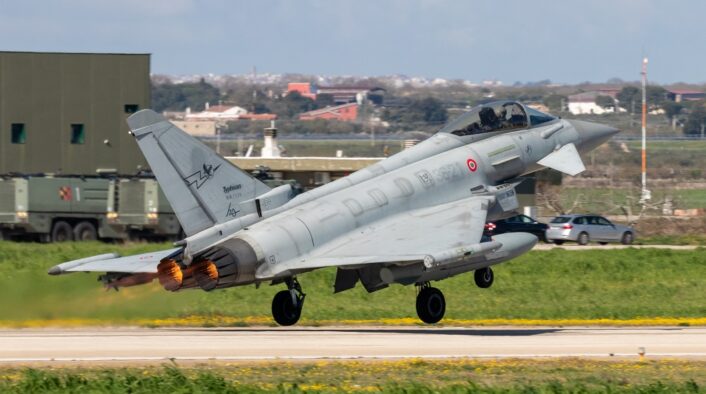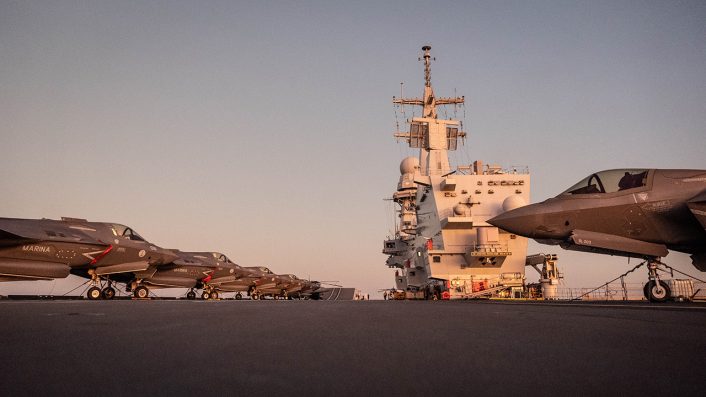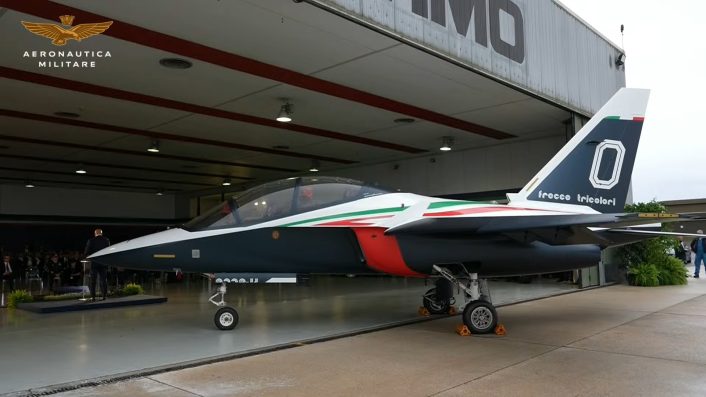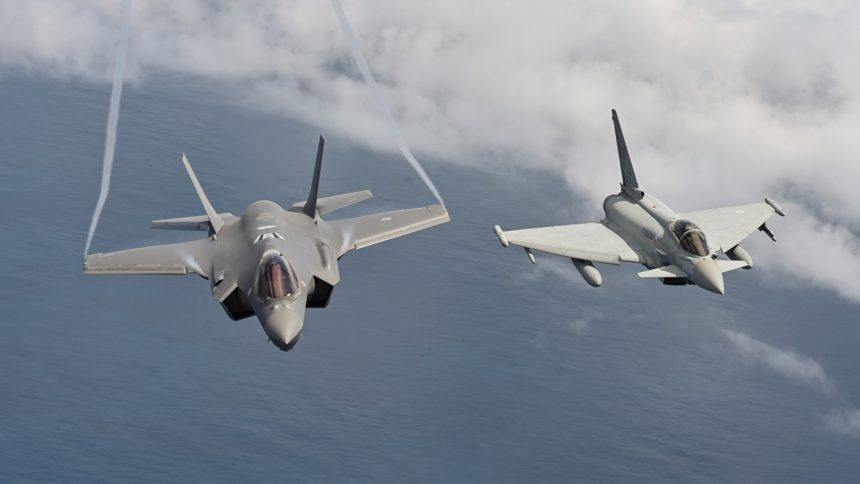The Italian MoD is still continuing the heavy modernization efforts of the recent years, with the announcement of the acquisition of 25 F-35s and 20 M-346s in addition to the already announced 24 Eurofighters.
The Italian government published on Sep. 17, 2024, the annual multiyear defense planning document (Documento Programmatico Pluriennale della Difesa), which reviews the military funding for 2024-2026. The document illustrates the funding needed by the Italian military to sustain and modernize its forces, which are undergoing many changes to adapt to modern scenarios.
This year’s edition includes the continuation of many programs already announced in previous editions and throughout the year, as well some previously unannounced acquisitions. Among these are a new batch of F-35 5th gen fighters and M-346 trainers, which add to the Eurofighters announced earlier this year.
The scenario
Once again, the strategic situation is based on a reference scenario called the “extended Mediterranean” region, characterized by persistent instability factors which reflect on the interests and the security of Italy. Among the major factors affecting the region, the document mentions the Russian-Ukrainian war and the Israel-Hamas war.
The Russian attack on Ukraine is said to have represented a breakpoint in the international dynamics and was followed by a deep polarization on a global scale, highlighting the contrast between the liberal-democratic and the authoritarian-totalitarian models.
The war in Ukraine, which saw a “traditional” war return to Europe, brought back to the public debate the use of the military in a conflict between nations, highlighting the need to reacquire adequate readiness and efficiency levels. The war also shocked the economy and commerce, showing the need to review the energy supply chain and strategic infrastructures, with the imperative of increasing the national resiliency.
The crisis in the Middle-East also represents a concrete threat of regional escalation, as shown by the involvement of multiple state and non-state actors in the conflict which followed Hamas’ attack in October 2023. A first expansion of this conflict was the new front in the Red Sea, where Houthi militias continue to attack merchant shipping lanes and Israeli/U.S. targets.
Iran is considered as one of the main factors of instability in the region and there are concerns about a direct involvement in the conflict after the first direct attack against Israel and the threat of the new attack. The risk of a “spill-over” of the current conflict might have devastating effects on a global level, mentions the document.

Army programs
The Italian Army is continuing the programs announced last year for the new Main Battle Tank and the Army Armoured Combat System. The former will supplement the upgraded Ariete C2 MBTs, providing a full multi-domain integration of the tank regiments, while the latter will replace the current tracked vehicles which are affected by obsolescence and critical inefficiencies.
The service is also moving on with the acquisition of the M142 HIMARS (High Mobility Artillery Rocket System), finalized to increase the deep and precision strike capabilities of the Italian Army, as well as new light and medium artillery systems. An interesting mention also goes to precision stand-off fires and loitering munitions, which the service intends to acquire.
The plans also include the acquisition of new Remotely Piloted Aircraft (RPA) to satisfy the need for Intelligence, Surveillance and Reconnaissance (ISR), as well as the increase of the cyber and air defenses. The latter include the acquisition of the Grifo SHORAD (Short Range Air Defense) system, equipped with the CAMM-ER (Common Anti-Air Modular Missile Extended Range), and a new battery of the SAMP/T surface to air missiles.
The document later mentions the acquisition of micro (less than 2 kg), mini (between 2 and 20 kg) and light (between 25 and 150 kg) drones for the aforementioned purpose, satisfying the needs of all Army’s components as well as dual use in support of civilian authorities. A further specification of the program mentions fixed and rotary wing UAS systems, divided in short (1 hour, 10 km), medium (4 hours, 40 km) and long range (more than 10 hours).
As for the Army Aviation, the service is focused on maintaining the operational capabilities of the NH-90, CH-47 and AH-129 fleets, as well as the continuation of the AH-249A NEES (Nuovo Elicottero da Esplorazione e Scorta – New Exploration and Escort Helicopter) program. The latter is the only new Western combat helicopter designed from scratch in recent years and incorporates advanced technologies which make it a force multiplier in multi-domain operations.
Navy programs
Similarly to the Army, the Italian Navy is looking at the acquisition of new RPAs for ISR, both fixed and rotary wing. The service is also starting with the Air Force the joint acquisition program for the first two new Maritime Multi Mission Aircraft (M3A) which will provide a long-range Anti-Submarine Warfare (ASW) capability.
Among the combat forces, in addition to the modernization of the naval assets, the acquisition of two new FREMM frigates and the development of new patrol ships and anti-mine ships, there is also a potentiation of the F-35 fleet. In fact, as part of the order of 25 new F-35s, the Navy will get 5 additional F-35B, bringing the total to 20 aircraft.
This adds to the recent news of the future integration of the F-35B on the ITS Trieste Landing Helicopter Dock (LHD). In fact, the government’s documents show the launch of the program to complete the preparation for the 5th gen aircraft, following the predisposition in the design phase. The goal is to have an “Alternate Carrier Vessel” able to operate with the F-35B when the ITS Cavour is not available.

Air Force programs
Moving over to the Air Force, the service is continuing the acquisition of the P-MMMS (Piattaforma Multi-Missione, Multi- Sensore/Multi-Mission, Multi-Sensor Platform) for a full Airborne Early Warning – Battlefi eld Management & Communication (AEW-BM&C) capability. The program is aimed at obtaining a modern asset that can be integrated in a net-centric C4ISTAR architecture and later adapted for multi-domain operations.
The P-MMMS program includes three variants of the G550: the CAEW (Conformal Airborne Early Warning), JAMMS (Joint Airborne Multi-sensor Multi-mission System) and EA (Electronic Attack). For the latter, the DPP mentions once again the intention to acquire the EC-37B. No new details were released, although the document mentions the renewal of the leasing of the Spydr aircraft to maintain a SIGINT (Signal Intelligence) capability until the P-MMMS is fully available.
Also, the service confirms the intention to continue the modernization of the MQ-9 fleet, the acquisition of the EUROMALE drone and the joint M3A program with the Navy. We already covered in depth the modernization of the Predator B (the name Reaper has not been adopted in Italy) fleet, with the upgrade and acquisition of additional MQ-9A Block 5 airframes.
The EUROMALE program is the first unmanned aerial system (UAS) designed for flight in non-segregated airspace. The airframe is a twin-turboprop with pusher-propeller engines being developed by an Airbus, Leonardo and Dassault consortium. The system is set to provide a generational leap compared to current assets, integrating open architecture, high modularity and ease of evolution.
Regarding the M3A program, the details are limited. Since the retirement of the Breguet 1150 Atlantic in 2017, Italy lost the long range ASW capability, as the P-72s are mainly used for ISR and ELINT (Electronic Intelligence). The studies for this program have been ongoing since then, with some rumors mentioning a possible interest in the P-8 Poseidon, but so far the MoD has not released specific details.
The Air Force is focused on the consolidation of its position in the Global Combat Air Programme (GCAP), the development program for a 6th gen aircraft. New funds have been assigned to the program, which is intended to develop the new fighter jet, the manned-unmanned teaming, effectors and sensors together with all the required technologies.
The fleet will also see an increase, with the already known acquisition of 24 Eurofighter Typhoons and the newly announced acquisition of 20 F-35s (of which 15 F-35As and 5 F-35Bs), 20 M-346s and the start of a Light Utility Helicopter program.
The Tranche 4 of Typhoons will replace the 26 aircraft of the older Tranche 1, whose phase-out is planned for 2029. After the positive evaluation by the government, the program is now moving on with the approval. While details are scarce, the aircraft are likely to be in the same configuration of the latest acquisitions by the other operators, possibly integrating also the Phase 4 Enhancements upgrades.
The acquisition of the new M-346 is mainly due to the adoption by the Frecce Tricolori as replacement for the 40 years old MB-339. In fact, out of the 20 aircraft, 15 will be assigned to the Frecce Tricolori and the remaining 5 will join the other 18 currently used for training by the 61st Wing and the International Flight Training School (IFTS). No details have been provided whether the aircraft will be in the new Block 20 variant.

Joint programs
Among the joint programs, an interesting mention goes to the research and development of Artificial Intelligence and Emerging Disrupting Technologies. The MoD intends to create a network of research centers which will work in synergy with specialized civilian industry to acquire the know-how and potentiate this sector.
Another interesting mention goes to the counter drone and directed energy weapon systems. The MoD, in fact, intends to develop a new tool to counter mini and micro drones for an initial capability to be integrated both in the air defense and force protection roles.
Among the other joint programs is the acquisition of loitering munitions able to conduct ISR and engage targets. The focus is to increase surveillance, command and control capabilities while having the capability to engage targets with low risk of collateral damage.
The new helicopter flight school being established in Viterbo, currently home of the Army’s flight school, is moving forward. The new school will exploit the ItAF’s expertise in this sector, as project lead, with the aim of satisfying the requirement for a joint national training centre for all helicopter pilots, as well as satisfying the requirements for the equivalent civilian licenses and offering training to international partners. The new DPP mentions the school will also be interconnected with the Navy’s Rotary Wing Mission Training Center.
The project is based around an Integrated Training System (ITS) which will include the LUH and the Ground Based Training System (GBTS), similarly to the one of the International Flight Training School. The school is expected to employ the new AW169 Light Utility Helicopter to satisfy the requirements of the phase 3b of the training, exploiting the gradual replacement of the six legacy helicopter fleets with the new helicopter. This phase, currently performed with the UH-139, is the intermediate step between the training of the phase 3a on the TH-500 and the helicopters of the operational units.
The planning mentions once again the works for the completion of the MC-27J Praetorian program, a special variant of the Spartan developed to provide support for the Special Forces of the Comando Operativo Forze Speciali (COFS). Previously, it was said three C-27J that were already in service and the ItAF were converted to the Praetorian configuration with the addition of mission systems, C3ISR equipment and a palletized ATK GAU-23 30mm automatic cannon, the same used by the USAF AC-130J. The latest DPP now mentions that in 2022 the modification works started on one aircraft to bring it to the initial MC-27J configuration, which will be used to inform the final configuration.
Regarding the F-35 joint program, the document mentions the already known start in 2022 of the acquisition, after the Phase 1 and Phase 2a tranches, of the Phase 2b tranche of 35 aircraft, bringing the total to planned 90 aircraft. The 25 new aircraft mentioned before are part of a new Phase 3, which the new DPP mentions is a response to the mutated geopolitical scenarios, and will bring the total fleet to 115 aircraft.
The document also mentions that the Phase 2B includes updates and logistical support until 2032, as well as the new bases in Grottaglie and Decimomannu. In fact, Grottaglie is being adapted to be ready to host the Navy’s F-35s, which are currently based in Amendola together with the Air Force’s F-35s. Decimomannu was announced as a new F-35 location last year, however there are no details available about that plan.









